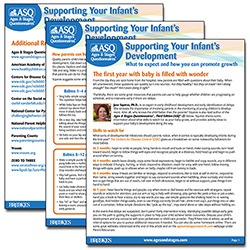How ASQ Educates Families About Child Development

Due to the pandemic, parents and caregivers have been spending more time with their child and may not have as close a connection to their child’s teacher and/or care providers. Many parents may be wondering if their child’s development is progressing in a healthy, age-appropriate way. They may have questions: is my child on track for key milestones? Do they need extra help in any developmental areas? What can I do to help my child keep making developmental and social-emotional progress?
ASQ® can help. More than a trusted screener, it can also be used to clarify what healthy development looks like at each age, advise parents when there may be an area of concern, and support developmental progress between screenings. ASQ facilitates education and support for all parents—not just when their child scores in the monitoring or referral zone, but when their child scores above the cutoff (ASQ®-3) or below the cutoff (ASQ®:SE-2), too. In this article, we’ll explore how ASQ can help you inform, educate, and empower parents—during the pandemic and beyond.
Educate Parents About Milestones
 When it comes to development, many parents may have questions about what to expect as their child grows and begins to acquire new skills. Parents may wonder if their child should be walking already, initiating play with other children, or saying more than a few words at their developmental stage. Every child is unique and develops at their own pace, but there are certain milestones most children should reach by a certain age. ASQ is perfect for educating families about these developmental and social-emotional milestones.
When it comes to development, many parents may have questions about what to expect as their child grows and begins to acquire new skills. Parents may wonder if their child should be walking already, initiating play with other children, or saying more than a few words at their developmental stage. Every child is unique and develops at their own pace, but there are certain milestones most children should reach by a certain age. ASQ is perfect for educating families about these developmental and social-emotional milestones.
First, the actual process of screening with ASQ is a helpful way to educate parents. When you talk to them before the screening, introduce the concept of developmental milestones and link it to the importance of early and regular screening. You might tell parents:
- Developmental milestones are abilities achieved by most children by a certain age.
- Developmental screening provides a quick check of your child’s development. You can think of it as a snapshot of your child’s motor, cognitive, language, and social-emotional skills.
- Screening will help determine if your child is meeting the appropriate milestones for their age.
- Your answers will show your child’s strengths so you can celebrate the progress they’ve already made, and highlight any areas in which your child may need more support.
(Read more here: Helping parents understand the benefits of developmental screening)
ASQ-3 covers five key developmental areas, and ASQ:SE-2 covers seven key social-emotional areas. Before screening, introduce parents to these specific areas in clear and simple terms. For example, here are some things you might say when introducing ASQ-3:
“There are five areas of development on the ASQ-3”:
- Communication: “This refers to children’s language skills and includes what they can say and what they can understand.”
- Gross Motor: “This refers to children’s use and coordination of larger muscles, like arms and legs when they move and play.”
- Fine Motor: “This refers to children’s movement and coordination of smaller muscles, like hands and fingers.”
- Problem Solving: “This refers to children’s problem-solving skills and how they play with toys.”
- Personal-Social: “This refers to children’s self-help skills and their interactions with others.”
After you score ASQ, share results with parents and highlight the milestones their child has reached. Skills marked “Yes” in ASQ-3 and skills marked with a “Z” on ASQ:SE-2 are milestones that should be pointed out to parents and celebrated as strengths. Skills marked “Sometimes” should also be noted—remind parents that “sometimes” means the child is just beginning to demonstrate a skill, and delight with them at the new attempts their child is making.

On the ASQ website, we also offer Developmental Milestones articles customized for parents of infants, toddlers, and preschoolers. These articles, broken down by age range, are a clear and useful tool for helping parents understand what to expect and approximately when to expect it. Each article also includes tips and strategies for supporting development and additional resources for parents.
Highlight and Discuss Areas of Concern
Prior to screening, tell parents that another crucial function of the questionnaire is to determine whether their child needs additional support or assessment in one or more areas. Parents and caregivers may be reassured about the concept of screening if they know how beneficial it is to identify concerns early, when their child can reap the benefits of early intervention, rather than waiting until the child starts school.
After an ASQ is scored and it’s time to share results, inform parents about any items of concern and discuss any possible contributing factors before you focus on next steps.
For ASQ-3:
- Review items marked “Not Yet” and discuss any parent concerns.
- Gather more information from the parent about what they may have tried or observed.
- If relevant, discuss factors that may have impacted the child’s performance: opportunity to practice skills, the child’s health (e.g., hearing, vision), the family home, culture or language.
For ASQ:SE-2:
- Review items scored as 10 or 15 points, and discuss these items of concern.
- Talk to parents about factors that may be affecting the child’s behavior: setting/time, health, development, family/culture variables, stress or trauma.
If a parent expresses a concern about their child’s development or behavior, be sure to talk to them about it, regardless of whether the ASQ results indicated a potential issue. Parents may be worried about a behavior that’s actually age appropriate, and reassurance from you will alleviate their concerns. For other concerns, you may need to provide parents with more follow-up and support to help them understand and address the issue or behavior.
Looking for additional resources to help lay the groundwork for a smooth post-screening process? Here are some resources for further reading:
Prepare before you share ASQ screening results
ASQ Parent Conference Forms
Success After Screening
Support Progress Between Screenings
Many families may still have concerns about their child’s development, even if their ASQ results don’t necessitate a referral to a pediatrician, mental health professional, or early intervention service. And even parents who don’t have immediate concerns will still benefit from concrete strategies for supporting their children’s developmental and social-emotional growth.

Regardless of whether you plan to make a referral, be sure that families know they play a critical role in addressing developmental or social-emotional issues at home. ASQ Learning Activities and Parent Activities are both easy-to-use, engaging ways to support healthy child development between screenings and promote close parent–child interactions. ASQ Parent Activities feature fun, simple activity ideas for boosting the development of children ages 2 months to 5 years, and versions for both ASQ-3 and ASQ:SE-2 can be downloaded and printed for free from the ASQ website. The ASQ Learning Activities are books of fun, low-cost, and developmentally appropriate activities that were specially created to complement ASQ-3 and ASQ:SE-2. These activities are a valuable follow-up tool that can benefit many families, including:
- Families of children whose ASQ-3 or ASQ:SE-2 screening results indicate that development is on schedule, and with whom you want to follow up
- Families of children whose ASQ scores indicate the need for monitoring
- Families who share general concerns or questions during the screening process, regardless of their children’s total scores
- Families of children with scores in the referral area (below the cutoff on ASQ-3 or above the cutoff on ASQ:SE-2) but found not eligible for services
Among many other things, the pandemic has highlighted the essential role parents and caregivers play in nurturing young children’s healthy development. Before, during, and between screenings, the ASQ system is designed to expand parents’ knowledge of child development and increase the number of opportunities for them to support their child’s ongoing, long-term success.


